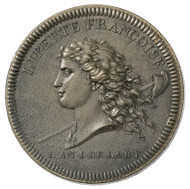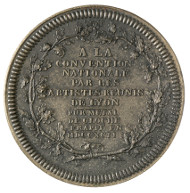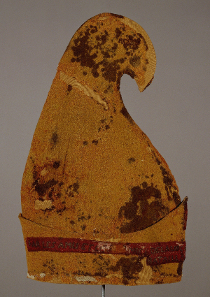courtesy of the MoneyMuseum, Zurich
translated by Teresa Teklic
Why was the human head the motif on coins for centuries, no, for millennia? And why did that change in the last 200 years? Ursula Kampmann is looking for answers to these questions in her book “MenschenGesichter” (“Human faces”), from which the texts in this series are taken.
France. Medal, issued on behalf of the united artists of Lyon in 1792. Head of Liberty with streaming hair, facing left, over her shoulder a staff with Phrygian cap, below the inscription (translated) “Year 1 of the French Republic”. R. Inscription (translated) “To the National Assembly from the united artists of Lyon, struck from pure bell metal in 1792” surrounded by oak wreath. © MoneyMuseum, Zurich.
On 10 August 1792, the National Assembly disposed of Louis XVI. An event that had seemed unthinkable at the beginning of the revolution. The whole nation was talking about it, and not only in the streets. The clubs, where like-minded Frenchmen all across the country were exchanging ideas, were the places for political debate. Their members further organised united action to spread revolutionary ideas.
One club from Lyon, for example, had the idea to express its enthusiasm about the year’s events in the form of a medal in the fall of 1792. An official delegation of artists from Lyon was to hand over this piece, whose obverse would certainly have made a good choice for the overdue new coinage without royal portrait, to the National Assembly.
Liberty was the theme of the medal. She had received a new face for this medal. While she had been portrayed as a chaste maiden in an ancient robe with orderly dressed hair, the new portrait now expressed the enthusiasm of a whole generation, which was willing to fight for its ideals. And with her hair open and flowing behind her as if she was running, the personification of liberty looked just like her contemporaries during the Storming of the Bastille. The enthusiastic conviction of these people was so great that the new ideals spread to all nations. In 1792, the predominant sentiment was, in fact, still a boundless optimism. And after the first victories of the French army, the National Assembly promised that France would support all oppressed peoples of the world.
Phrygian cap, Heeresgeschichtliches Museum Vienna. Source: Wikicommons.
The main forces behind this missionary movement were the Jacobins and the sans-culottes, who were wearing the Phrygian cap as a symbol of their revolutionary disposition. And it was precisely this “bonnet rouge” (“red cap”) that the artists from Lyon chose as an attribute for their Liberty.
In Lyon, however, the enthusiasm for the ideals of the French Revolution did not last much longer. In March 1793, the National Assembly sent out commissioners into all provinces in order to “rein in” the people outside of Paris. For the citizens of Lyon, that was the straw that broke the camel’s back. Not all of them were radical Jacobins, but many of them willing to use violence, if necessary, to enforce their political conviction. So, in July 1793, Lyon witnessed what Paris called a counterrevolution. It was brutally put down and Lyon cleansed from all “reactionary” forces by means of the guillotine.
The theme of liberty, which can be found on so many coins, will be continued in the next episode: this time on Swiss coins.
You can find all episodes in the series here.
A German edition of the book “MenschenGesichter” is available in print and as ebook on the site of the Conzett Verlag.








